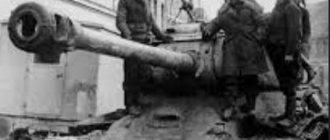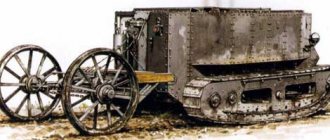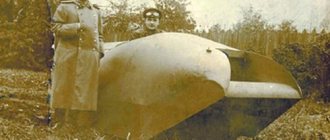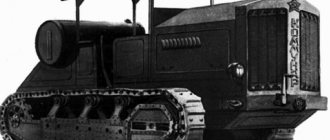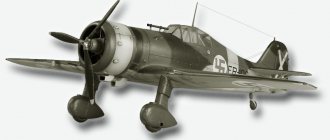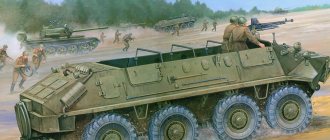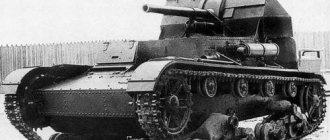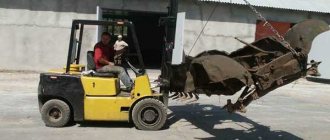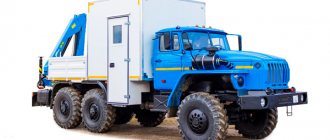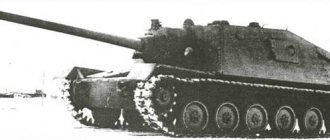Tests of the first prototype of the tank - "Machine No. 1 Lincoln" - turned out to be quite successful. Her “father” Ernest Swinton in September 1915 sent “upstairs” cheerful reports like: “The sailors managed to build the first copy of a tracked vehicle that moves through ditches 4.4 feet wide (about 1.3 m - Ed.) and elevations 4 feet 6 inches (about 1.5 m. - Ed.) and spinning around its axis, like a dog with a flea on its tail.” In reality, things were less rosy. The tractor chassis was not ready for the loads that a production tank would have to experience on a daily basis. In addition, the vehicle's tracks kept falling off. The prototype had to be either urgently brought to fruition, or (also urgently) offered a worthy alternative.
Device of the firstborn
The body of the car resembled an armored box.
At the front, in the control compartment, there were two drivers with distributed responsibilities. The right driver controlled the engine using pedals, changed gears with a lever and controlled the wheel “tail” using a winch. The left one was responsible for the operation of the tracks - left and right separately. Using a handbrake, he controlled the speed of each of them. The main difficulty in working on the first prototype of the future tank was the need to make it quickly, but at the same time, efficiently.
At the rear of the vehicle, the designers placed an engine and transmission compartment with a Foster-Daimler carburetor engine with a capacity of 105 horsepower. The fighting compartment was located in the middle of the vehicle, but Vehicle No. 1 Lincoln did not yet have weapons. They also developed a rotating turret for the prototype, but have not yet begun to install it. That is, the “proto-tank” design was two years ahead of the French Renault FT 17, which for many decades became the trendsetter in the classic layout of combat vehicles.
How to equip the new equipment - this issue was discussed hotly and actively by the military and engineers. The creators really wanted to equip the vehicle with a 40-mm Vickers automatic cannon. But Feldzeichmester General Stanley von Donop, the head of the British artillery, warned: it could take up to six months to deliver a large batch of these guns. And since “machine gun fighters” (as Swinton’s machine was called then) it made sense to produce only in large quantities, it was advisable to guess the weaponry in one try, without delay. As a nameless participant in the tank's work darkly joked: "We'll look stupid if the war ends the next day." Alas, the war was not going to end yet.
"Little Willie" The history of the very first British tank in history
On August 3 in London, Colonel Crompton was notified of their arrival, after which he was given instructions to immediately deliver them to Barton-on-Trent to the experimental test site (in simple terms - a training ground) belonging to the 20th Squadron of the Royal Air Naval Service. Crompton himself lingered at home in Kensington Court, where he prepared drawings for the Admiralty Committee on Landships and at the same time tried to control the activities of numerous contractors supplying components for some new and very strange machines.
"Little Willie" in Wembley Park in London, where he is viewed by a British Royal Navy officer
The work at Barton was led by Lieutenant Walter Wilson, but things went slowly, or rather, not as quickly as everyone would have liked. By this time, the Committee on "Land Ships" had already agreed that these same ships should be equipped with tracks rather than wheels, but many of its members advocated making such "ships" articulated (like some modern Swedish and Russian all-terrain vehicles ), but Wilson himself did not approve of this idea, because he was worried about the strength and reliability of such a connection. The calculation was that if one half of the landship got stuck in a crater from a heavy shell, the other would be able to pull it out. In fact, during testing, this connection bent and broke - and it was precisely this that Wilson tried to improve. As for the new tractors, they were intended for a machine designed by Colonel Crompton, which had no joints in the chassis!
Meanwhile, Wilson's reports on the impossibility of making an “articulated ship” gave rise to considerable despondency in the Committee. Albert Stern, secretary of the Committee, whose headquarters were at Pell Mellstreach in London, immediately contacted the engineer William Tritton of William Foster and Co., who was involved in the Committee's project (and therefore it could be assumed that she would also cooperate with Crompton, as with all his other designers).
Stern contacted Tritton by telephone, and they agreed that if the joint could not be brought to working condition, then the “land ship” would have to be made consisting of only one section. Meanwhile, the tractors that had arrived from the USA had already been sent to Lincoln, to the Tritton plant, where all those interested in the project arrived on August 11. Both Tritton and Walter were very dubious about the quality of American cars. For example, it was known that if you do not engage the track shoes with the drive sprockets right at the factory (and at that time this operation was usually performed with a sledgehammer!), then it becomes very difficult to do this later. But the worst thing was that the company that produced these particular machines did not take into account Crompton’s special recommendations for their manufacture, although he had handed them over to the American side in advance.
Thus, it was planned to sharply increase the length of the tracks on all tractors so that they would be much longer than the tracks on tractors. But at the same time, Crompton had concerns that very long tracks that fit tightly to the ground would be very difficult to control, and he suggested that the company reduce the length of contact between the tracks and the ground to 5 feet 4 inches, like conventional tractors, and for this purpose the nose raise part of the tracks, and lower their middle part.
But in Lincoln it turned out that the tracks on all tractors along their entire length were made horizontally adjacent to the ground (like modern crawler excavators), which could not but irritate the extremely hot-tempered Stern.
"Little Willie" - rear view
As a result, as Tritton later wrote about this, the first tractor on these tracks was completed on September 8, 1915. The next day, the car was tested in the factory yard. As expected, she turned out to be completely uncontrollable, and was never tested again in this form. By September 14, it was modified by raising the chassis on special brackets - braces that support tractor rollers. On September 19, the new car was shown to members of the Committee: Eustace Tennyson D'Aincourt, Ernest Swinton, Mr. Hetherington, who stubbornly advocated “articulated ships,” and Wilson himself. Covered in a tarpaulin, the first real-looking tank in the history of mankind was transported to Cross Cliff Field, not far from the city, and there it was driven around, but the show did not make much of an impression on those gathered, since the tracks often slipped off the guide wheels.
However, just two days later, on September 21, his famous telegram went from Tritton to London to Stern: “Ballad died at the test site yesterday morning.” Tritton's new achievement is a stamped iron plate. Weighs less but is very durable.
We now know that Tritton worked very quickly, since the creation of a “land ship” was a priority at that time, and he had a well-equipped engineering plant at his disposal. However, could they really achieve such success in just two days? After all, we are not talking about a simple improvement, but about the creation of a fundamentally new track, and it could hardly be developed and manufactured overnight. After all, it was necessary to make accurate drawings for casting the base of the track, stamp the plates themselves, then fasten it all together with bolts, for which it was necessary to mark and drill mounting holes, and finally, the tracks had to be connected so that the caterpillar belt assembled from them would not fall apart later ! And if all this did not exist, then how could Tritton, solving this problem only speculatively, be completely confident that such a design would work? After all, it was not without reason that it was said about the Balata belt drive that it died because it turned out to be unsuitable for such a serious machine as a tank.
The truth, most likely, is that Tritton and Wilson were working on the new tracks, as well as the entire caterpillar belt, long before the first tractors came to them for testing. But even in this case, he did not yet have the new type of tracks themselves, since it is known that it was December before they were made in metal. This means that Tritton, sending his telegram, had only a sketch of a new caterpillar belt in his hands, but relied on his instincts as an experienced engineer and, as we know, subsequently he was right.
"Little Willie" - front view.
On December 3, 1915, the prototype of the vehicle was equipped with new tracks and a chassis frame and was taken out of the workshop for testing, which was to take place right in the yard. The new machine immediately impressed everyone as complete and technically fully responsive to the task. If earlier the inner part of the track was open, now it was covered with a metal sheet, providing greater rigidity to the wheel pairs. Now one could hope that the track chains would no longer fall off them. In addition, they were now designed so that even if the car were lifted off the ground by a crane, they would not sag more than an inch on it!
One can only imagine how happy both Tritton and Wilson were when they looked at this creation, but it was unlikely that they were going to celebrate this event, since they already knew that work on the Little Willie tank would not be continued. Interestingly, this name itself appeared purely by accident. As they say, the company’s employees thought that the machine created at their enterprise was somewhat similar to its designer Wilson, so they christened it so strangely. However, the first car of Tritton and Wilson was called “No. Lincoln" (in honor of the city where the plant he allocated was located), so there is no need to be particularly surprised here.
The most interesting thing, however, is that Tritton and Wilson also began working on the design of the famous diamond-shaped “Mother” tank, which became the prototype of all subsequent British tanks of this type, somewhere in mid-August, and by December the wooden model was ready. Thus, it was more than obvious to both of them that they had produced a stillborn child and that their main contribution to this design was the tracks and the tracks themselves. During testing, the tank moved rather awkwardly, mainly due to the massive tail bogie with large diameter steering wheels. With the help of special cables, the driver could deflect it to the right or left and thereby force the car to turn. Of course, the turning radius was very large. However, the width of the ditch surmounted by the tank seemed insufficient to the military, as well as the height of the vertical obstacle it surmounted, which automatically put an end to the “Little Willie” project, no matter how perfect it turned out to be later modified.
Assembly of tank “No. 1. Lincoln." As you can see, at this stage of construction this tank had a very respectable turret, quite suitable for installing a 40-mm automatic pom-pom in it
At the same time, it should be said that this tank was more consistent with the technical specifications issued for it than the one that Tritton and Wilson subsequently obtained. Indeed, according to the project, the “land ship” was supposed to be armed with a 40-mm automatic “pom-pom” cannon installed in the turret, a machine gun in the frontal armor plate and have holes in the hull for firing from personal weapons available to its crew. On the Lincoln, the turret model was still standing, but on the Little Willie it was not even installed, concentrating all efforts on improving the chassis. On the other hand, a turret-mounted tank armed with a rapid-firing gun would be much closer to modern vehicles than the somewhat strange and unusual-looking English “rhomboids”, which never produced any “offspring” due to their uselessness.
However, the story of this very first British tank in history did not end there.
In January 1916, Ernst Swinton went on an inspection trip to Hatfield Park, where he was supposed to inspect the testing grounds for the new car. Arriving there on Sunday, he saw that the work was nevertheless proceeding quite successfully, but also found a military band playing there and many military personnel with their families, which they took with them to spend this Sunday afternoon with them. There, just a few feet away from the crowd, stood two strange cars covered with a tarp.
It is clear that these were both prototypes of the first British tanks - both the first and the second, and it was then, according to Swinton, that they were called “Big” and “Little Willie”. This version of the origin of both names is somewhat different from the generally accepted one, but who can now vouch for the reliability of certain information after so many years?
Be that as it may, after some time “Little Willie” ended up in Wembley Park in London, and without the rear wheels. At this time, Wembley was a testing ground for the Department of Trench Warfare, but by the end of 1917 it had become a veritable graveyard for experimental tanks. “Little Willie” arrived on the site of the future Royal Tank Museum in Bovington in 1919, and he was certainly here in 1928, when the camp located here was visited by King George V, who was photographed next to him during a walk. True, then this English tank was overgrown with thorns and stood in this form for at least about 20 years. Legends from the Second World War claim that "Little Willie" served as one of the anti-landing defenses on the approaches to Bovington, that it was hidden because it was considered a national relic, and that it was transported to Gloucestershire and installed on the airfield there as a pillbox to counter the German landing. Of course, the circumstances at that time were extraordinary, and yet the last legend is hard to believe, it looks too unlikely.
The same tank undergoing sea trials in Lincoln. For some reason the tarpaulin covering the tower has not been removed
Be that as it may, “Little Willie” was still preserved, although the engine and some internal parts were removed from it. Today this exhibit of the Royal Tank Museum in Bovington is completely inoperable and resembles a nut shell, since the inside is completely empty, although it looks very good on the outside. In 1980, it was repainted in a matte gray color, which, according to experts, is much closer to its original color than the “deep bronze green” - “green with a bronze tint” - the color of British tanks of the Second World War, in which, apparently, , it was at this time that this rare tank was painted. Now it is in a place of honor in the history hall, where any visitor to this museum can see it. For modellers, this is not as attractive a vehicle as, say, the Soviet T-34 or the German Tiger, but for those who like to make rivets, this is just what you need.
PS It is interesting that after testing “Little Willie” as a running platform for a combat vehicle, the British did not even attempt to test at least some weapons on it. The model of the tower with the “pom-pom”, of course, does not count. Having removed it, the designers installed an iron sheet in its place with a small gap and thus created something like a flat-shaped “ventilation fungus”. True, the vehicle was equipped with nine firing embrasures, but nowhere is it mentioned that the “Little Willie” was ever fired on the move.
Meanwhile, the design of “Little Willie” made it possible to equip it with two side sponsons hanging over the tracked mover on the left and right, and in each of them install either two machine guns or two 37-mm Hotchkiss guns. The cannon version of the tank in this case would be armed with four cannons and 1-2 machine guns, one of which, like on the base tank, would be located in the front armor plate, and the second would be transferred to the desired embrasure as needed. The machine gun version would have 5 machine guns and would not be inferior in this regard to the heavier “Mother” tanks of the Mk.I, II, IV, V models.
True, as already noted, the designers did not like the vehicle’s maneuverability, and therefore they chose the “diamond version” of the chassis, but even in this version, the very first British tank would have been practically inferior to the French Schneider CAI tank.
Why nothing like this was ever done, and the very first British tank was never tested by fire - today one can only guess...
The article was published in the September 2009 issue of the journal Science and Technology
Found a typo? Select a fragment and press Ctrl+Enter.
Tags: Land equipment “Little Willie” England tank
Previous article Why England abandoned the slave trade, and Russia abandoned serfdom
Next article Consequences of colonization. White slaves of the New World
Provided by SendPulse
Likes 0
Procrastination and its cost
While in good old England the military and designers were racking their brains over fine-tuning the new machine, another major operation was being prepared at the front - the September offensive of the Anglo-French troops near the city of Loos in Northern France. In his book on the First World War, the British historian Basil Liddell-Hart titled the chapter on this operation “The Unwanted Battle.” And General Douglas Haig gloomily about. Unfortunately, the French command thought otherwise. Result? “...This day was a day of tragedy, and there was not a single glimmer of success that could soften its bitterness,” one can read in the official British history of the First World War. Casualty statistics indicate almost 60,000 killed and wounded between September 25 and mid-October 1915.
If the British had tanks, this terrible figure could be significantly reduced. It’s not the engineers’ fault, they did everything they could, but at that time “Car No. 1 Lincoln” had just gone to be finalized. An improved prototype was almost built when Britain sent Swinton and company's main backer, Winston Churchill, first into retirement and then into the trenches.
On the front line, Churchill saw how soldiers lacked reliable support and powerful means of attack. He inspired commanders: “About seventy [tracked vehicles] are now nearing completion in England. None should be used until all are ready at once... They are capable of bypassing any ordinary obstacle, overcoming a ditch, parapet or trench. They carry two or three Maxim machine guns and each can be equipped with a flamethrower. Nothing short of a direct hit from a field gun will stop them...” In fact, history developed quite differently, and Churchill was almost a year ahead of the curve.
At the end of November 1915, an improved prototype was ready. One of the employees of the company that built the car decided that it looked like one of the designers, Walter Wilson, and gave it the name “Little Willie.” Its hull was assembled with rivets from boiler steel sheets, it began to look different than its predecessor, and received a protrusion in the bow. The undercarriage guide rollers were now raised above the ground to make it easier for “Little Willie” to move over rough terrain. “Willy” was ready for new tests, but the tank fathers had already renounced their brainchild, because they were working on a vehicle of a completely different design and with a different, non-turreted, weapon layout. If you believe Swinton’s memoirs, this idea was inspired by the fantastic story of H. Wells “Land Armadillos”.
The new car was still hidden in the deepest secrecy when it got a name.
Armored train on tracks
In the 19th century, Edouard Bouyen's tracked armored train was introduced, which became the prototype of the world's first tanks. According to the inventor's idea, tightly connected trains were supposed to move not on rails, but on a closed caterpillar belt.
The train was supposed to be equipped with powerful guns, and the crew size could reach 200 people. And although Bouyen’s brainchild was never created, the scientist believed that such a train could radically change the philosophy of war.
When cars began to be produced at the beginning of the last century, the first tanks began to be developed at the same time. At this time, armored vehicles were very popular.
However, their disadvantage was that they were practically unable to overcome obstacles in the form of trenches, vegetation or barriers.
Armored train Buyena
When machine guns, anti-personnel mines and other projectiles began to be used in military conflicts, engineers had to think about creating a machine that could not be stopped by any type of weapon.
We also recommend reading: Details you should know about Papomobile
Mask, what's your name?
The Chairman of the Landship Committee, Eustace Tennyson d'Encourt, was literally obsessed with the conspiracy surrounding the promising creation of Swinton and his colleagues. Even British airplanes were strictly prohibited from flying over the Foster plant while the machine was being assembled. But there was still a risk that rumors about the unusual car would leak out. Therefore, it was necessary to come up with a code name for the technique - at least to divert attention. Moreover, such that the potential spy would not even understand what is hidden behind him. The main thing: no hints of ships, even land ones.
On November 4, 1915, the prototype was dubbed the “water carrier.” He lived with this name almost until the New Year. On December 24, Swinton and Lieutenant Colonel Daly Jones of the Imperial Defense Committee decided to replace him with someone else. Options considered were “container”, “tank” and even “reservoir”. In the end, we settled on the short and sonorous word tank (Russian “tank”, “capacity”). The legend implied that the factory was building water tanks to be sent to the colonies in Mesopotamia. But by that time, the British crown had already lost its possessions in Mesopotamia, so the Russian Empire had to be appointed as the imaginary customer.
No one, except for a narrow circle of select people, even remotely imagined what the shape of the hull of this “tank” would be. Various tests were carried out, as a rule, at night. For example, the designers decided to test the strength of the armor of the new vehicle. Military intelligence helped obtain samples of German ammunition.
On January 12, 1916, shooting took place in a field near the ancient Lincoln Cathedral. Hetherington bet Wilson £50 that he would pierce the hull with the first shot, and he himself stood behind the gun. Either the debaters placed the tank poorly, or they aimed carelessly, but the matter almost ended in a scandal. Hetherington fired. The gun misfired, but after a few seconds the primer still worked and fired a so-called “lingering” shot, sending the projectile directly towards the cathedral. The best engineering minds in Great Britain raced to the church to make sure that they had not caused damage to it, and then spent another two hours walking around the area with flashlights and shovels in search of the shell.
Further tests demonstrated that the tank’s armor can withstand impact. All that remains is to conduct a decisive experiment, showing your creation to its customers. At first they wanted to do it at Wembley Stadium, but then they decided that it was too public a place. A running prototype of the “tank” was sent by rail to the estate of the Marquess of Salisbury in Hatfield. There, under Swinton's control, an obstacle course was built. The demonstration and testing of the unprecedented military machine was scheduled for February 2, 1916.
The cream of the military-political leadership of Great Britain gathered at the estate: Minister of Supply D. Lloyd George, Minister of Foreign Affairs Lord Arthur Balfour, Chief of the Imperial General Staff General William Robertson. Even “Lord Kay” himself, Secretary of War Horatio Kitchener, the main opponent of tanks, honored the event with his presence. The winter sun was already setting when the distinguished guests were greeted by an armored monster of an unprecedented diamond shape with the roar of an engine. Talking about his impressions, Lloyd George did not skimp on his emotions: “A feeling of amazing admiration took possession of me when I saw this ugly monster called the Royal Centipede.” This is how the first production tank entered testing in a spectacular manner.
Tank by Leonardo da Vinci
At the end of the 15th century, the great Leonardo da Vinci (see interesting facts about Leonardo da Vinci) managed to design a tank made of wood and metal. It was shaped like a spinning top.
The inventor placed cannons along the perimeter of the circle. Such an unusual machine had to be driven through complex mechanisms. This allowed the Renaissance tank to move across the surface autonomously.
However, Leonardo's ideas were so ahead of the time in which he lived that the project remained only on paper. An interesting fact is that in 2009, American engineers were able to recreate the tank according to the drawings of the great Italian.
Today[edit]
Little Willie was preserved for posterity after the war, rescued from scrapping in 1940, and is today on display at the Bovington Tank Museum. It's essentially an empty hull without an engine, but with some internal fittings. The rear steering wheels are missing, and there is damage to the body trim around the right-hand visibility slit, possibly caused by an attempt at some point to tow the vehicle by running a cable through the slit. This could tear the relatively thin steel plating of the tank. [6]
Lincoln car number 1[edit]
Lincoln No. 1
with extended Bullock tracks and Creeping Grip tractor suspension, September 1915.
Work on Little Willie's predecessor was begun in July 1915 by the Landship Committee to meet the United Kingdom's World War I requirement for an armored fighting vehicle capable of crossing an 8-foot (2.4 m) trench. After several other projects in which single and triple tracks failed, on July 22, William Ashby Tritton, director of the Lincoln-based agricultural machinery company William Foster & Company, was awarded a contract to develop a "Tritton machine" with two tracks. It was to use track units—extended tracks and suspension components (seven road wheels instead of four)—purchased as completely built ones from the Bullock Creeping Grip Tractor Company of Chicago.
On August 11, actual construction began; On 16 August, Tritton decided to install a tail unit to aid in steering. On September 9, Lincoln Machine number 1, as the prototype was then called, made its first test run in the Wellington foundry yard. It soon became clear that the track profiles were so flat that the ground resistance during turning was excessive. To solve this problem, the suspension was changed so that the underbody profile was more curved. Then the following problem was discovered: when crossing the trench, the caterpillar sagged, and then again did not fit the wheels and jammed. The tracks also could not support the weight of the vehicle (about 16 tons). Tritton and Lt. Walter Gordon Wilson tried several types of alternative track designs, including balat belt and flat rope. On September 22, Tritton developed a strong but crude-looking system that used pressed steel plates riveted to cast links and integral guides to engage the inside of the track frame. The track frames as a whole were connected to the main body by large spindles. [1] This system was unsprung, as the tracks were firmly held in place and could only move in one plane. This successful design was used on all British tanks of the First World War up to the Mark VIII, although it had limited speed.
